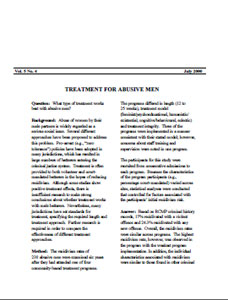Treatment for abusive men
Research summary
Vol. 5 No. 4
July 2000
Question
What type of treatment works best with abusive men?
Background
Abuse of women by their male partners is widely regarded as a serious social issue. Several different approaches have been proposed to address this problem. Pro-arrest (e.g., "zero tolerance") policies have been adopted in many jurisdictions, which has resulted in large numbers of batterers entering the criminal justice system. Treatment is often provided to both volunteer and court-mandated batterers in the hopes of reducing recidivism. Although some studies show positive treatment effects, there is insufficient research to make strong conclusions about whether treatment works with male batterers. Nevertheless, many jurisdictions have set standards for treatment, specifying the required length and treatment approach. Further research is required in order to compare the effectiveness of different treatment approaches.
Method
The recidivism rates of 230 abusive men were examined six years after they had attended one of four community-based treatment programs. The programs differed in length (12 to 25 weeks), treatment model (feminist/psychoeducational, humanistic/ existential, cognitive/behavioural, eclectic) and treatment integrity. Three of the programs were implemented in a manner consistent with their stated model; however, concerns about staff training and supervision were noted in one program.
The participants for this study were recruited from consecutive admissions to each program. Because the characteristics of the program participants (e.g., percentage court-mandated) varied across sites, statistical analyses were conducted that controlled for factors associated with the participants' initial recidivism risk.
Answer
Based on RCMP criminal history records, 17% recidivated with a violent offence and 24.3% recidivated with any new offence. Overall, the recidivism rates were similar across programs. The highest recidivism rate, however, was observed in the program with the weakest program implementation. In addition, the individual characteristics associated with recidivism were similar to those found in other criminal populations (e.g., young, single, prior convictions and lifestyle instability).
Policy implications
- At present, there is insufficient evidence to justify the imposition of any specific treatment approach with male batterers. It is possible that community-based treatments are effective in reducing violent recidivism, but the most effective way of treating abusive men has yet to be identified.
- Programs providing interventions for abusive men should ensure that the staff are appropriately trained and supervised.
- Given the similarity in risk factors between abusive men and other offenders, the same intervention strategies that work for general offenders may also work with male batterers.
Source
- Hanson, R. K., & Wallace-Capretta, S. (2000). A multi-site study of treatment for abusive men. User Report 2000-05. Ottawa: Department of the Solicitor General of Canada.
For further information
James Bonta, Ph.D.
Solicitor General Canada
340 Laurier Avenue West
Ottawa, Ontario
K1A 0P8
Tel (613) 991-2831
Fax (613) 990-8295
e-mail jim.bonta@ps-sp.gc.ca
- Date modified:
